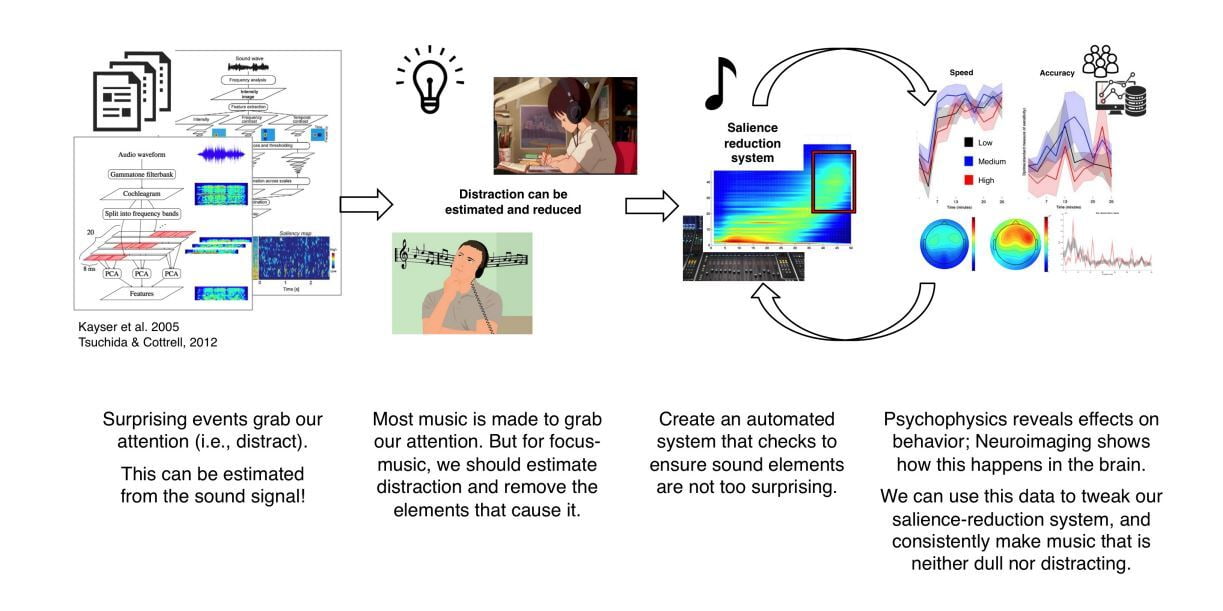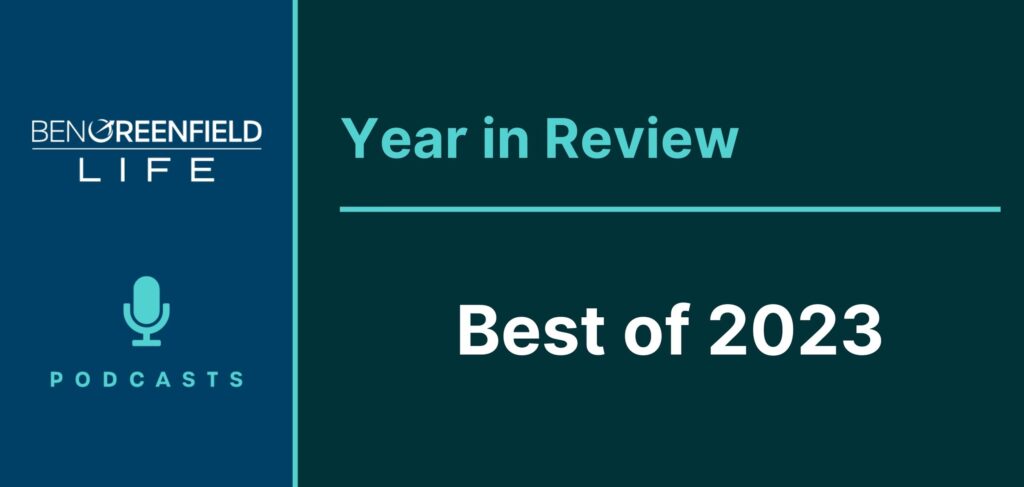April 26, 2022
I tend to be a bit of a geekie tech nerd when it comes to finding and experimenting with different tactics for maximizing my mental state or altering my state of consciousness for goals such as better focus or creativity or sleep.
So I'm always on the lookout for new ways to unlock a desired brain state in order to maximize my ability to get into a state of deep focus for writing, or enhance creativity for making music, or shift into an ultra-relaxed state to effortlessly drift off to sleep at night—whether that's via nootropics, plant compounds, meditation, breathwork, biohacking devices, or, as you're about to discover in this article, via something called “brainwave entrainment.”
Now, maybe you're a productivity junkie like me and have already dabbled in things like focus music, isochronic tones, binaural beats, or white noise. If so, I want you to keep reading, because it turns out there's a lot of misinformation out there when it comes to what technology will actually produce a measurable effect on your brain.
So, that's why I'm having a true expert, my friend Dan Clark, CEO of Brain.fm (who I recently interviewed on my podcast), help shed some light on the real science behind brainwave entrainment, what it is, what it isn't, and the best ways to use it to help you skyrocket your productivity, calm your mind, and sleep like a baby (however, as my twin boys like to often correct me, “babies don't sleep that well, Dad”).
In this article, Dan will be covering common questions that I asked him when we had dinner together a few months ago, including:
- What is “brainwave entrainment”?
- What frequency bandwidths are associated with different mental states?
- Do you have to use headphones for this kind of technology to work?
- Isn’t this the same as binaural beats?
- And much more…
You're going to learn some new things about using sound correctly, I guarantee. Enjoy!
The Science of Brainwaves
Your brain is made up of billions of brain cells called neurons, and your neurons (just like the rest of your body) use electricity to communicate with each other. As you can probably imagine, these millions of neurons sending signals all at once produce an enormous amount of electrical activity in your brain. This activity can actually be detected using medical equipment like electroencephalography (EEG), which measures the electricity levels over areas of your scalp.
When you graph this electrical activity, you generate what is called a brainwave pattern. Brainwaves, also known as “neuronal oscillations,” happen in very characteristic, rhythmic patterns that show up as wave-like lines.
There are four distinct types of brainwaves that all correlate to different mental states.
1. Beta
Brainwaves recorded by EEGs are measured in frequency (how many brainwaves or cycles per second, unit of Hz) and in amplitude (the electrical potential or how many cells fire at the same time at the same speed, expressed as voltage).
Beta waves have a frequency ranging from ~15 to 40 Hz and have a comparatively low amplitude. These brainwaves are most commonly associated with a brain that is engaged and active, such as when formulating an argument, giving a presentation, or solving a complex logic problem.
2. Alpha
As brainwaves decrease in frequency (and typically have a corresponding increase in amplitude), they are associated with more and more relaxed, less active mental states. According to the late Ned Herrmann in Scientific American, “alpha waves represent non-arousal. A person who has completed a task and sits down to rest is often in an alpha state. A person who takes time out to reflect or meditate is usually in an alpha state.” These are typically associated with frequencies between ~9 and 14 Hz.
3. Theta
Theta brainwaves are associated with mental relaxation and daydreaming, as well as with times when you get some of your most creative insights, such as during automatic tasks like showering, running outdoors, or brushing your teeth. Theta waves have frequencies between ~5 and 8 Hz, and often have higher amplitudes than alpha or beta waves.
4. Delta
Finally, you have delta brainwaves, which are the slowest (clocking in between ~1.5 and 4 Hz), have the highest amplitude, and are most often associated with deep, dreamless sleep.
Now, here's where it gets interesting. Most of us live the majority of our lives in a state of primarily beta brain waves – aroused, alert, concentrated, but also somewhat stressed.
When we lower the brain wave frequency to alpha, we can put ourselves in an ideal condition to learn new information, perform more elaborate tasks, learn languages, analyze complex situations and even be in what sports psychologists call “The Zone”, which is a state of improved focus and performance in athletic competitions or exercise. Part of this is because the slightly decreased electrical activity in the brain can lead to significant increases in feel-good brain chemicals like endorphins, norepinephrine, and dopamine.
So, for example, when you meditate, you are focusing on something, whether it's a candle flame or your breath going in or out, or a mantra or a prayer. When you focus like that, the electrical patterns in your brain slow down and relax, and the amplitude of your brain waves generally stabilizes in the alpha wave range.
But it turns out that you don't need to be a trained monk or meditate for weeks on end to be able to achieve this state of alpha brain wave relaxation.
By understanding the different brainwaves and the mental states they correspond to, it's possible to use technology to “entrain” our brain to match these frequencies and nudge our minds into achieving the corresponding state.
What is Brainwave Entrainment?
“Brainwave entrainment” technically involves any method that causes your brainwave frequencies to fall into step with a specific frequency. It's based on the concept that your brain has a tendency to shift its electrical frequency towards the frequency of whatever dominant external stimulus it is exposed to—whether that's via light, electromagnetic energy, or in the case of Brain.fm, sound.
In short, brainwave entrainment is the process of influencing your brainwaves through your sense organs. This allows you to reach different states of consciousness, such as deep relaxation or expanded states of awareness.
That might sound like a bit of a reach, but the truth is, our brains are already well adapted to entrainment from external stimuli. One example that exists cross-culturally is that of dancing. When a song comes on that has just the right rhythm, you almost can’t help but move your body (or at least tap your feet or bob your head). It’s an embodied phenomenon that can’t necessarily be explained logically, and yet is something we do automatically without thinking. We lock in the rhythms of our bodies to the rhythm of the world around us.
So how does this relate to using entrainment to get your brain into a more focused, relaxed, or meditative state?
Well, as you just learned, specific “neural oscillations,” or brainwaves, are tied to certain brain states. You can think of them as “fingerprints” of certain cognitive processes. Newer research shows us that when we modify these oscillations to match up with a desired brainwave, we can also see improvements in cognitive performance and working memory. It also happens that using sound is one of the most effective methods for modifying brainwaves. For example, in sleep research, simple acoustic stimuli like clicks and pink noise have been used to drive slow-wave activity, producing benefits to deep sleep and memory retention.
Over time, the brain can also become more receptive to these stimuli, meaning with repetitive use, your brain will become “trained” to respond to the stimuli and reach the desired mental state more quickly. Pretty neat, huh?
How to Hack Your Brainwaves with Brain.fm
Brain.fm induces brainwave entrainment through your auditory senses with scientifically-designed “functional music,” helping you reach your desired mental state on demand. You just turn it on, and you'll feel the desired effects within five minutes.
Brain.fm uses non-invasive neurotechnology that can shift you into an altered or elevated state of consciousness, with no plant medicines, nootropics, or drugs required. The technology used involves patented key processes for creating functional music, including technology to elicit strong neural phase-locking—allowing populations of neurons to engage in various kinds of coordinated activity—and technology to remove distraction in sound.
To entrain brainwaves to specific frequencies, Brain.fm uses a unique technique called “amplitude modulation.” Amplitude is just a fancy term for the volume of a particular sound (you can see the relationship to the word amplifier), and in the case of Brain.fm, modulation is the rapid adjustment of the volume of certain layers of the music. Since the desired brainwave frequencies range from .25 to 20 Hz, this modulation produces not so much a tone (20 Hz is barely high enough to be audible by human ears), but more of a rhythmic “pulsing” sound, somewhat similar to the sound of a helicopter.

Research out of Cornell University shows that our brains respond to the exact kinds of auditory stimuli that Brain.fm uses, in this case showing improvement in sustained attention to response (SART) tasks, which are the gold standard for conducting attentional experiments. The result is that, over time, your brainwaves begin to align with the frequency of the amplitude modulation, resulting in a much easier time dropping into the associated mental state.
If you're curious about more of the science behind Brain.fm and how it works, you can also read our White Paper right here.
Now at this point, maybe you're thinking: how is this different from binaural beats?
That's a fair and commonly asked question—but the truth is that, when it comes to the technology and supporting research, they vary quite a bit indeed. So next I'll tell you how Brain.fm is different from other “auditory stimuli” often masquerading as brainwave entrainment.
Brain.fm Versus Art Music, Binaural Beats, and White Noise
 If you look up “brainwave entrainment” on the internet, you'll often find it associated with phrases like “isochronic tones,” “binaural beats,” “white noise,” and a smattering of Greek letters.
If you look up “brainwave entrainment” on the internet, you'll often find it associated with phrases like “isochronic tones,” “binaural beats,” “white noise,” and a smattering of Greek letters.
So the question is, what makes Brain.fm different, and is it measurably better than the alternatives?
Brain.fm Versus “Art Music”
As mentioned, Brain.fm uses “functional music,” which is designed to elicit a specific neurological response, and importantly, it fades into the background.
This is quite different from “art music,” or most other genres that are designed to be listened to and actively engaged with. If you consider the role of a good producer nowadays, the whole idea of most music is to capture your attention—not to fade away and let you focus on the task at hand.
By contrast, the specially-trained composers over at Brain.fm have taken great care to reduce the potential for distraction to a minimum. For starters, certain frequencies have been eliminated altogether from the music that can be distracting to the brain. This also helps reduce ear fatigue in long listening sessions.
Likewise, using tailor-made artificial intelligence algorithms, each track is composed with long listening sessions in mind (20-60+ minutes) as opposed to the usual 3-5 minute song. The idea here is that the transition from one short track to another can be jarring or distracting. However, these compositions aren’t totally repetitive; each track changes subtly over the course of an hour (or in some cases, longer) so that various musical elements come and go, maintaining just enough variation to keep it from becoming annoying.
Brain.fm Versus White Noise & Relaxation Music
Unlike art music, white noise and “relaxation music” are actually composed with the intent of fading into the background. Brian Eno’s “Music for Airports” is one of the more classic examples, and was an early pioneer in the genre of ambient music.
While these options are great for blocking out distractions and for getting you into a certain emotional state, they lack both the technological “boost” that the amplitude modulation of Brain.fm provides, as well as the studies to back it up. I’ll cover some of those details in the next section.
Brain.fm Versus Binaural Beats
Once you hear the way that the amplitude modulation sounds in the tracks on Brain.fm, it’s hard to not compare them on some level with binaural beats. However, the acoustic techniques used here differ from binaural beats in several important ways.
Binaural beats are produced when you have two tones that are close to each other in pitch, but not quite the same. One pitch (say, for example, 440 Hz) will be played in one ear, and a different pitch (for example, 450 Hz) is played in the other ear. The difference in these two pitches creates an interference pattern at the speed of the difference between the two frequencies (in this case, 10 Hz, which is in the range of Alpha brainwaves).
Unfortunately, there are a few problems with using binaural beats for brainwave entrainment.
The first is that, from a pure research perspective, there’s actually very little effect from using this technique. Part of the reason for this is that the beat that’s being produced is happening as an auditory “illusion” in the brain stem, rather than as an actual stimulus from a sense organ, as is the case with the type of amplitude modulation that Brain.fm is using. Since the auditory effect is being created in the brainstem, it's limited in how “loud” it can be, and thus how heavy the signal is that's being sent up to the cortex. Even one of the very first studies of binaural beats as a diagnostic tool mentions that binaural beats have a very weak entrainment response.
Secondly, even if the binaural beat was producing any meaningful effect, it would be destroyed if you listened to anything besides the single tones that are produced. This can get pretty monotonous (pun intended) after a while, and the effect—which again, is minimal—would be diluted by the addition of relaxation music, white noise, etc. For the reason just mentioned, you’re completely limited to using headphones to get the binaural effect. (Though to be fair, we do recommend using headphones also with Brain.fm because of certain spatial effects, but you can still get a good result without them)
And, the final difference is the music itself. Binaural beats tend to be simple tones, and have nothing to do with music, so they're not very enjoyable to listen to. With Brain.fm, you're getting the benefits of the amplitude modulation along with music scientifically designed for the brain by trained composers. (And, if you do hear “binaural beat music,” just know that it's simply music tracks overlaid on top of binaural beats, which can actually get in the way of the effectiveness of the beats.)
So as you can see, Brain.fm is quite different from white noise, binaural beats, or your basic “Focus” tracks playlist on Spotify—in design as well as effect.
Best Practices for Using Brain.fm
Now I'd like to share with you a few “insider tips” on using Brain.fm to get the best results. By following these tips, you'll likely notice an immense boost in your focus, productivity, sleep, and ability to relax.
Wear Headphones
Again, unlike binaural beats, the amplitude modulation that makes Brain.fm work doesn’t require headphones to take effect. However, there are some unique and highly effective built-in spatial sound features that make it worthwhile to use a pair of high-quality headphones when listening.
spatial sound features that make it worthwhile to use a pair of high-quality headphones when listening.
For example, with the “Sleep” listening sessions, the audio shifts subtly back and forth, which simulates the rocking of a hammock or a baby’s cradle. According to research sponsored by the Swiss National Science Foundation, this rocking sensation is especially effective at synchronizing brainwaves during short naps, which boosts the activity of sleep spindles, the pattern of brain waves that occur during non-rapid eye movement sleep.
With the “Focus” sessions, you'll also notice a subtle shift in where the sound is coming from over time. Initially, it will sound as though the music is coming from either side of you, and it will gradually shift to be directly in front of you, giving you an additional auditory cue to focus on what’s in front of you.
So headphones aren't necessary, but they definitely add to the experience. If you're using Brain.fm to help you with sleep or during a nap, try some soft, comfy headphones like SleepPhones.
Use It Regularly
The next best advice I can give is to use Brain.fm regularly. Most users notice that the more they use it, the more quickly they can “drop into the zone” which they're seeking. And as we covered, this repetitiveness is actually one of the ways that brainwave entrainment, or shifting your brainwaves to fall into a certain frequency aligned with a desired mental state, works best.
Try using it every time you're doing the activity in which you seek results, such as sitting down to work, meditating, or laying down in bed.
Try Pairing It with Other Technologies
As Ben mentioned on our podcast episode together, he's found that “stacking” Brain.fm with other entrainment technologies that target different senses can produce even greater results.
For example, he will turn on Brain.fm, and then:
- Attach the Apollo wearable around his ankle or wrist, which uses vibratory haptic sensation;
- Put on the Hapbee, a device that emits magnetic stimulation;
- Flip on a light therapy device such as the Joovv or Vielight;
- Use Brain.fm in a hyperbaric chamber or sensory deprivation tank;
- Try it with a tDCS device such as Halo;
Those are just a few ideas of great “stacks” for pairing with Brain.fm.
Summary
When it comes to having mental clarity, energy, and focus throughout your day, making sure your sleep, diet, and exercise are dialed in will get you pretty dang far.
But even with all your bases covered, it’s often nice to have a few tools in the toolkit for when you need to focus for long stretches of time, fall asleep faster, or quickly cut through the chatter of the monkey mind and drop into a meditative state.
To that end, I love being able to turn to better living through science with brain entrainment technology like Brain.fm, which is basically a nice little “cheat code” for turning my brain to the right dial. And if for some reason I'm not quite running on all cylinders on a given day, I’ve found that it’s a great way to get back into a focused state or take a quick nap (my favorite) to clear away brain fog in the middle of the afternoon.
So let's recap all the main points about brainwave entrainment, functional music, and how you can use Brain.fm to unlock different brain states:
- You have four types of brainwaves: beta, alpha, theta, and delta, which all correlate to different mental states.
- Brainwave entrainment is the process of influencing your brainwaves through your sense organs.
- Brain.fm uses auditory stimuli to lull the brain into a desired state, namely via scientifically-designed functional music that utilizes amplitude modulation.
- Brain.fm stands out against “art music,” binaural beats, white noise, and relaxation music when it comes to achieving a desired mental state.
So if you're looking for a non-invasive, highly effective technology that will help you crush your workday with superhuman productivity, achieve deep meditative states more quickly, and easily fall into a deep sleep each night, I'd highly suggest checking out Brain.fm (code BEN20 for 20% off)
What about you? What kinds of music or soundscapes do you use for focus, meditation, or sleep? If you’ve tried Brain.fm already, how do you feel it stacks up to the alternatives? Let me know in the comments section below, along with any thoughts, questions, or feedback you have!















Can this technology help with headaches or migraines.?